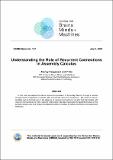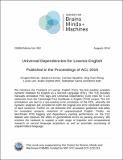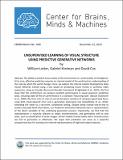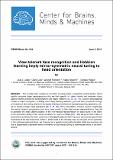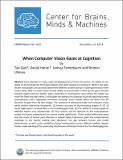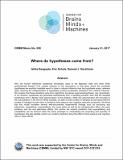Browsing CBMM Memo Series by Title
Now showing items 132-141 of 141
-
Understanding the Role of Recurrent Connections in Assembly Calculus
(Center for Brains, Minds and Machines (CBMM), 2022-07-06)In this note, we explore the role of recurrent connections in Assembly Calculus through a number of experiments conducted on models with and without recurrent connections. We observe that as- semblies can be formed even ... -
Universal Dependencies for Learner English
(Center for Brains, Minds and Machines (CBMM), arXiv, 2016-08-01)We introduce the Treebank of Learner English (TLE), the first publicly available syntactic treebank for English as a Second Language (ESL). The TLE provides manually annotated POS tags and Universal Dependency (UD) trees ... -
Unsupervised learning of clutter-resistant visual representations from natural videos
(Center for Brains, Minds and Machines (CBMM), arXiv, 2015-04-27)Populations of neurons in inferotemporal cortex (IT) maintain an explicit code for object identity that also tolerates transformations of object appearance e.g., position, scale, viewing angle [1, 2, 3]. Though the learning ... -
Unsupervised learning of invariant representations with low sample complexity: the magic of sensory cortex or a new framework for machine learning?
(Center for Brains, Minds and Machines (CBMM), arXiv, 2014-03-12)The present phase of Machine Learning is characterized by supervised learning algorithms relying on large sets of labeled examples (n → ∞). The next phase is likely to focus on algorithms capable of learning from very few ... -
UNSUPERVISED LEARNING OF VISUAL STRUCTURE USING PREDICTIVE GENERATIVE NETWORKS
(Center for Brains, Minds and Machines (CBMM), arXiv, 2015-12-15)The ability to predict future states of the environment is a central pillar of intelligence. At its core, effective prediction requires an internal model of the world and an understanding of the rules by which the world ... -
View-tolerant face recognition and Hebbian learning imply mirror-symmetric neural tuning to head orientation
(Center for Brains, Minds and Machines (CBMM), arXiv, 2016-06-03)The primate brain contains a hierarchy of visual areas, dubbed the ventral stream, which rapidly computes object representations that are both specific for object identity and relatively robust against identity-preserving ... -
Visual concepts and compositional voting
(Center for Brains, Minds and Machines (CBMM), 2018-03-27)It is very attractive to formulate vision in terms of pattern theory [26], where patterns are defined hierarchically by compositions of elementary building blocks. But applying pattern theory to real world images is very ... -
What am I searching for?
(Center for Brains, Minds and Machines (CBMM), arXiv.org, 2018-07-31)Can we infer intentions and goals from a person's actions? As an example of this family of problems, we consider here whether it is possible to decipher what a person is searching for by decoding their eye movement behavior. ... -
When Computer Vision Gazes at Cognition
(Center for Brains, Minds and Machines (CBMM), arXiv, 2014-12-12)Joint attention is a core, early-developing form of social interaction. It is based on our ability to discriminate the third party objects that other people are looking at. While it has been shown that people can accurately ... -
Where do hypotheses come from?
(Center for Brains, Minds and Machines (CBMM), 2016-10-24)Why are human inferences sometimes remarkably close to the Bayesian ideal and other times systematically biased? One notable instance of this discrepancy is that tasks where the candidate hypotheses are explicitly available ...

